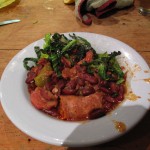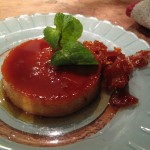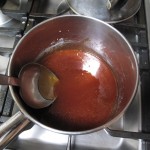Feijoada – Porkfest 2013
Main course is feijoada, Brazilian national dish and one of the Titan’s of Portguese cuisine. It’s a pretty easy dish and you can freeze it for an easy midweek meal – I had about 2kg of the stuff leftover: perfect for the Tim Ferris slow-carb diet.
Normally this festival of pork contains both Linguica sausage and Salipicao sausage. Linguica is smoked and cured, and made with garlic and paprika. It’s a bit like a cross between a frankfurter and a chorizo. Salpicao is more like a salami, strongly flavoured with wine and garlic and then oak-smoked.
You can buy both types of sausage here at www.portuguesefood.co.uk
I’ve had to bend the rules regarding authenticity here. Living in rural Devon there’s not a massive choice of international charcuterie – although we do have the amazing Happy Apple, which has an incredible range of stuff. This is a shop that not only has Thai shrimp paste, it has three different types – not bad for a town with only 8000 people.
I used a combination of Salami Di Milano, Chorizo and a peppery Hungarian salami alongside a smoked pork knuckle instead of a bog standard pork knuckle.
Feijoada Ingredients
- 500g pounds dried red kidney beans, rinsed
- 1 smoked pork knuckle
- 1 pound linguiça sausage (or chorizo)
- ½ pound salpicão sausage
- ¼ cup olive oil
- 1 large onion, chopped
- ½ cup freshly chopped flat leaf parsley1
- 1 bay leaf
- 4 cloves garlic coarsely chopped
- ½ teaspoon ground white pepper or to taste
- 1 tablespoon smoked paprika
- 1 tin chopped tomatoes
- Stock
- Salt to taste (if needed)
Feijoada Method
- Soak the pork knuckle overnight. Soak the beans overnight in separate bowl.
- Four hours before you want to serve, drain, rinse and put it in a big saucepan.
- Cover with water, bring to the boil and simmer until cooked – about 2 hours but I usually look to see if the meat is coming away from the bone and then taste it. When it’s cooked use a fork to pull the meat from the bone and shred.
- Drain and rinse the beans. Put in a saucepan, cover with water and bring to the boil. Turn the heat down and simmer until tender. Drain.
- When the meat and beans are both cooked you’re ready to put the dish together.
- Chop the sausage or salami into bite sized pieces. Heat some olive oil in a saucepan and sauté until coloured.
- Add the onions and continue cooking until they’ve gone golden brown (but not burnt)
- Add the smoked knuckle meat, garlic, bay leaf and paprika and fry until the garlic is just starting to turn golden, stirring continuously to stop the spices sticking.
- Add the tomatoes, mash up the tomatoes with a fork until there are no large chunks of tinned tomato – I just hate that. If you want to be even more anal about it puree it before you add.
- Add the stock and cook for half an hour. Add the beans and heat through. Taste and season.
Pudim Flan – Not Creme Caramel, Honest
Pudim Flan is the Portuguese version of Creme Caramel, another custard classic.I found several recipes online, all slightly different and some (especially the Brazilian version) using condensed milk instead of cream. My favourite version was here.
I’ve amended it slightly. It’s quite a tricky dessert to get right – both caramel and custard can go wrong pretty easily – so make sure you give yourself plenty of time to prepare. You’ll need to start at least 5 hours before your meal or the night before is even better.
Pudim Flan – Ingredients
Caramel
- 1 cup sugar
Custard
- 6 large eggs
- 3 cups milk
- 1 tsp water
- 1 tsp vanilla essence
- 1 cup sugar
- pinch salt
Making the caramel
Caramel can be a tricky old thing to manage. At the end of the day though it’s just melted sugar and as long as you follow a few simple steps, it’s fairly straightforward.
A few things to watch out for:
- Keep watching at all times. Don’t try and do anything else while you’re making it.
- Keep it on a fairly low heat. The sugar will cook quite quickly (5 – 10 minutes) and if it starts to boil too vigorously, it’ll be too late.
- If it goes too dark in colour and smells burnt, start again. Don’t be tempted to use burnt caramel.
- Don’t dip your finger into it or lick a spoon covered in hot caramel. Yes, yes it’s all healed now.
Get six oven-proof ramekins ready.
- Put the sugar into a saucepan and heat on a medium heat.
- The sugar will melt and then gradually darken in colour. It sounds obvious but when it’s a golden brown caramel take it off the heat.
- Leave to cool for a minute or so then pour to coat the bottom of each ramekin
Making the custard
- Heat your oven to 170 degrees
- Put the milk on to a low heat to simmer for five minutes until hot but not boiling. Take off the heat and leave to cool.
- Beat the eggs with sugar until pale. This means like a really pale yellow.
- Add the milk a little bit at a time and beat thoroughly into the eggs. Add the vanilla and beat into the egg mixture.
- Pour the egg mixture into each ramekin until it’s about 1 cm beneath the rim.
- Put the ramekins into a roasting tin and then fill with water to half way up.
- Cook in the oven for around an hour or until a cocktail stick comes out clean
- Chill for at least 4 hours, preferably overnight.
To serve, you need to put a plate on top of the ramekin and invert. I sat the ramekins in boiling water for a minute or so to help them come loose.






My favorite dessert! Thanks for the link exchange. Tia Maria
Cool! Having lived in Portugal, this is probably the best description of Feijoada that I’ve come across.
Thanks Maria – we loved it! Great recipe 🙂
Thanks Anders – ate the last bit from the freezer last night. Just working on my next post – Scotland!